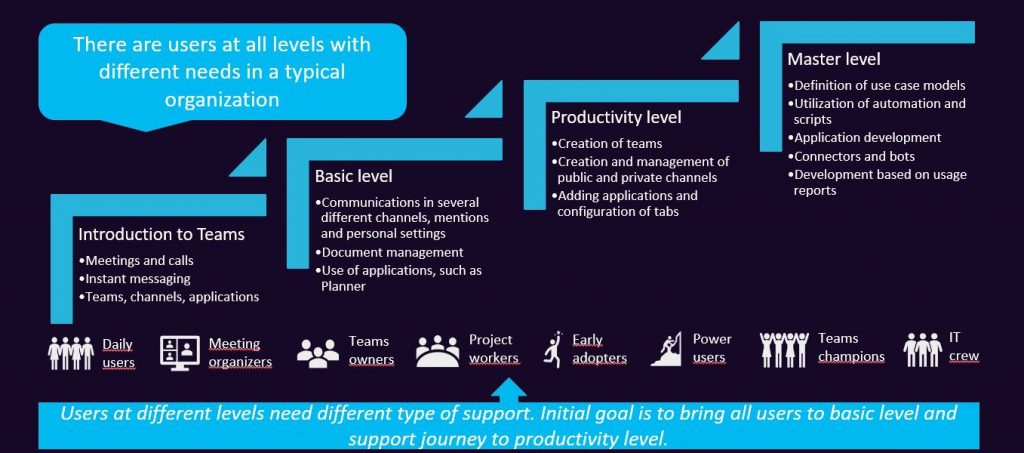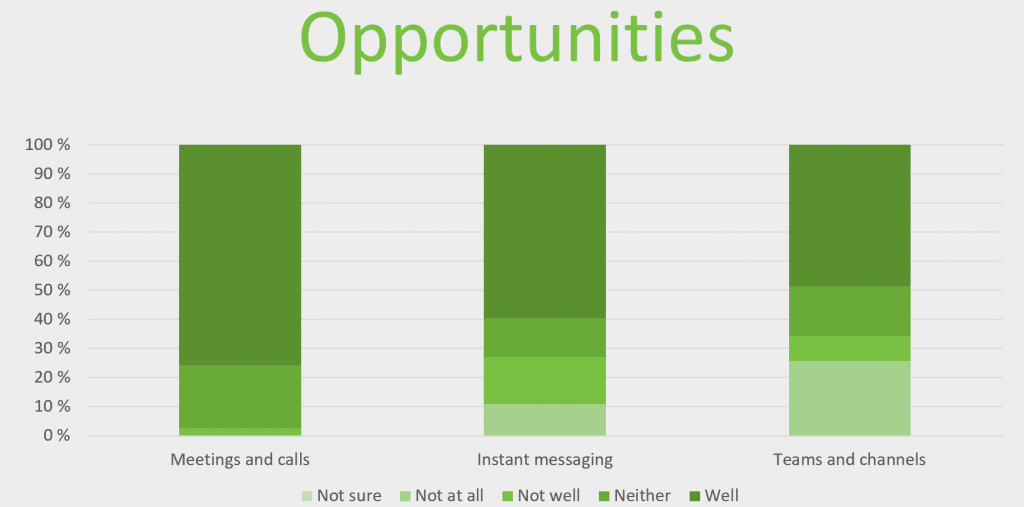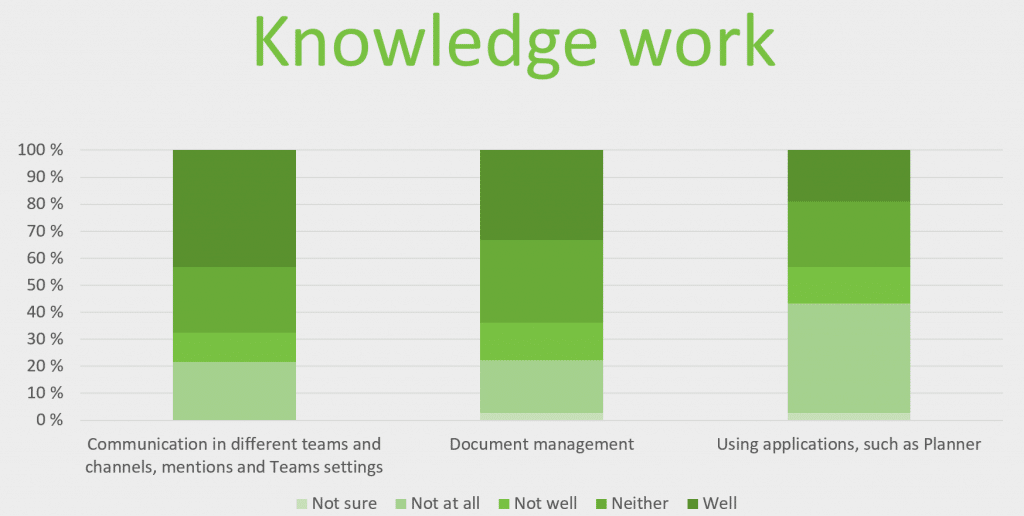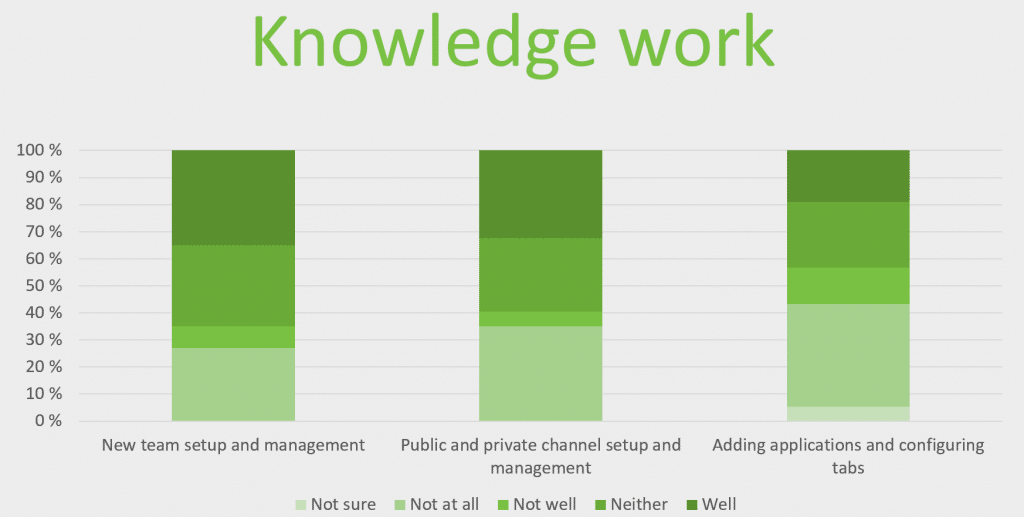Deploying Teams in large and small organizations is most successful when users’ competencies and organizational maturity are at the core of implementation.
The successful deployment of Microsoft Teams is a prerequisite for productive use of the new digital work environment.
According to Microsoft best practices, the deployment of Teams is understood as consecutive steps: getting started, experimenting, and expanding. At different stages, the importance of communication, training, Teams ambassadors, feedback, and refinement of objectives is emphasized. The security and manageability of the Teams environment are ensured through the design and implementation of a management model.
The model is functional but may seem unnecessarily heavy, especially in smaller organizations. The purpose of the model is to enable Teams to be deployed in a multi-thousand user organization new to the use of Teams, utilizing Teams ambassadors, i.e. pioneering users who are not only knowledgeable but also willing to learn more and share their knowledge with others.
In a small organization, finding and empowering pioneers to serve as Teams ambassadors is not always possible.
Maturity levels of Teams users
One of the most important things in deploying Microsoft Teams is the level of maturity of different users in terms of using Teams. Taking these different levels of expertise and Teams utilization into account is essential, especially when Teams is deployed across the organization.

In the model we developed, these different users are divided into four levels:
- Users familiarizing themselves with the use of Teams
- Teams users at the basic level
- Teams users at the productivity level
- Teams users at the master level.
In a typical organization, there are these different users at all levels. Users at each level need different support to develop their own skills and use Teams more diversely in their work and collaboration with colleagues.
Users familiarizing themselves with the use of Teams
At the first level are those who are familiarizing themselves with Teams’ functions and its use. They may attend meetings and calls at Teams and send instant messages. They belong to different teams and channels and may use some Teams applications.
Teams users at the basic level
Users mastering the basics of using Teams communicate seamlessly across multiple channels and teams. For example, they utilize the mention functionality of teams, channels, and individuals to draw the attention of colleagues to important or otherwise up-to-date information or resources. Teams’ basic users are well versed with document management and using applications like Planner may already be part of their day-to-day work.
Teams users at the productivity level
More advanced users set up Teams groups as well as private and regular, or public, channels that they manage independently. These users know how to take advantage of the tabs on different Teams channels and add applications and other resources to them, making it easier to access a frequently used tool or data source.
Teams users at the master level
Teams users at the top level, i.e. the master level, can independently develop applications, for example, and take advantage of automation, connectors, and bots to get the most out of working at Teams.
Training for everyone according to their level of competence
Training as part of the deployment of Teams usually aims to raise all users to a basic level and support their rise to the productivity level. Training, like the deployment of Teams, usually takes place in stages, proceeding according to the capabilities of the organization and its employees.
The slowly increasing use of Teams as part of established practices is often the most profitable and rewarding way to give everyone the confidence to take advantage of a new application and its versatile functions in their work.
Communication that supports the deployment of Teams and changes in operating methods, the monitoring of indicators, and the collection of feedback are important tools to develop operations and ensure the desired change.
For example, recording user training and storing the recordings on a separate training site may be one way to ensure that even those who did not attend the training can use the same information independently.
Feedback survey as a direction indicator
The feedback survey we use on Microsoft Teams users’ expertise before tool deployment and training provides good comparative information across multiple organizations.
The sections of the survey are divided according to the Teams maturity levels I presented earlier: familiarization, basic, and productivity levels.



Response rates are in line with these different levels of expertise: most users were at the level of familiarity with the use of Teams, which is the most typical starting point in most organizations. However, more users felt that skills connected to knowledge and management Teams were unfamiliar to them.
Feedback surveys are an excellent way to clarify the level of competence and training needs of your organization’s staff, creating an indicative roadmap for the organization’s goal and the ways how to achieve it.
Utilizing Teams with an attitude of continuous development
We have implemented several Teams deployments with organizations of all sizes and types in both the private and public sectors. Cooperation with our customers often continues even after the utilization of Teams as its use becomes topical in solutions that meet the needs of organizations.
With us, you plan the managed deployment of Teams from start to finish while considering all the needs of the organization and the users.
Henry Scheinin
Senior consultant








